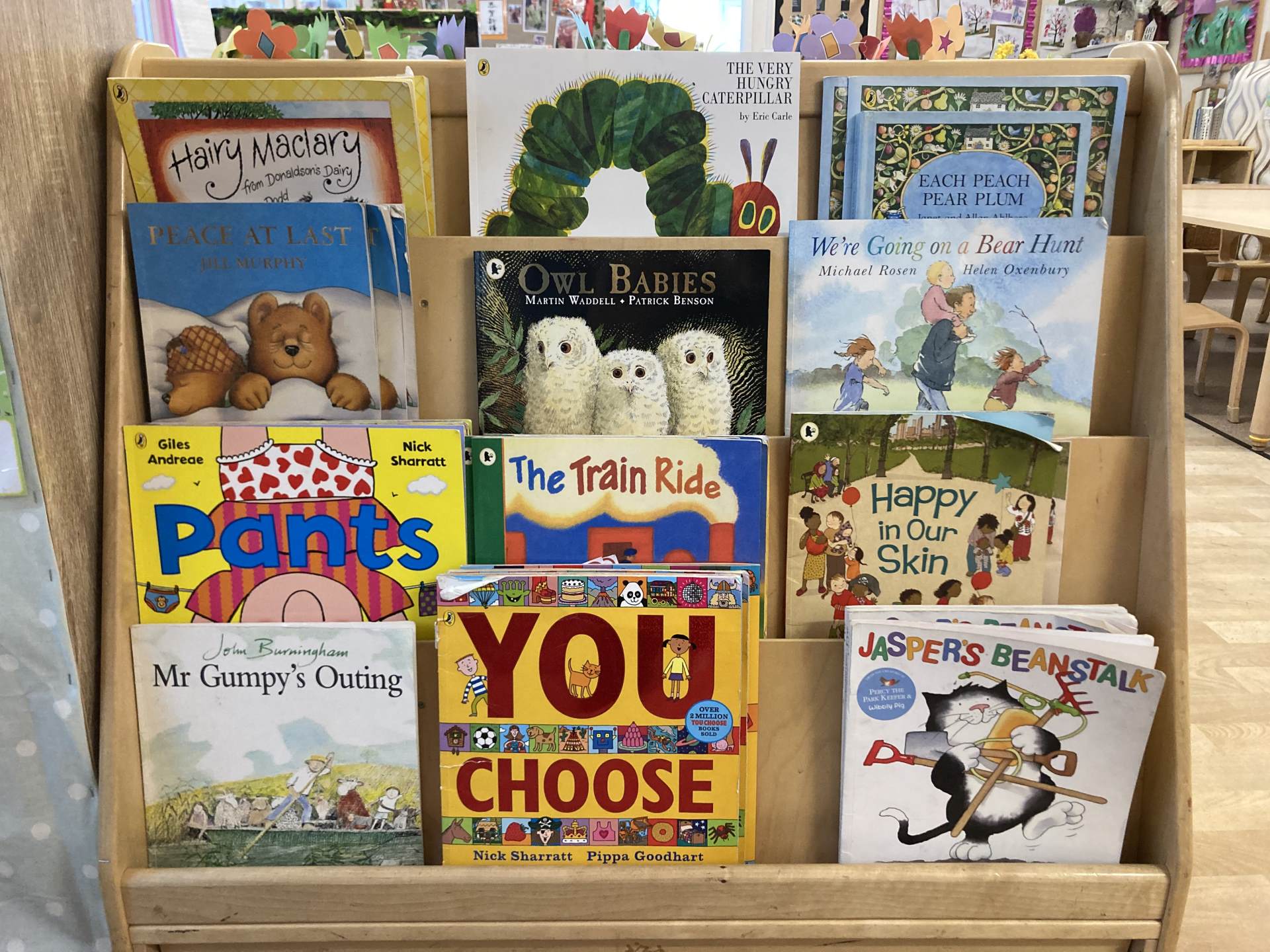Reading/Core Books/Phonics
“It is crucial for children to develop a life-long love of reading. Reading consists of two dimensions: language comprehension and word reading. Language comprehension (necessary for both reading and writing) starts from birth. It only develops when adults talk with children about the world around them and the books (stories and non-fiction) they read with them, and enjoy rhymes, poems and songs together.” (EYFS Statutory framework 2021)
At Peartree Way we want to empower our children to develop a life-long love of reading and we believe that children should be read to at least daily and experience a wide range of books and stories. We have a story time each day and texts are chosen carefully and supported by skilful questioning to develop reading skills. We have chosen our core books to develop a love of reading, with opportunities for children to enjoy these books repeatedly, allowing them to join in and ‘read along’ with the adult. Our core books are repetitive, predictable and many feature rhythm and rhyme. Small group activities are often planned to link to these books so that they become increasingly familiar to the children. Children who do not attend our pre-school provision will have the opportunity to explore and revisit the preschool books within our Nursery classrooms. Our core books are supplemented by many other books, giving the children the opportunity to follow their interests, learn about new things and experience genres or story styles that are new to them, and enjoy books liked to seasonal changes or different ways of life. Supplementary books include stories by the author Julia Donaldson, who we have identified is popular with our children and provides challenge through her composition and themes. We provide opportunities for children to ‘bump into books’ throughout our environments and these books are linked to different areas of learning and provision.
By the time children leave Peartree Way, our children will be confident to….
- respond to familiar rhymes and stories
- handle books carefully, turning pages holding the book the right way up
- look at books independently
- recognise familiar words and signs (including their own name, advertising logos)
- gain simple meaning by using illustrations, when not yet able to read text
- state simple likes/dislikes about familiar texts
- retell an event in a story or information from a non-fiction text
- sit attentively and listen to stories (at age appropriate stage )
- show curiosity about content in stories (may begin to discuss content and answer basic questions about a story. E.g. How? Why?
- have a core collection of stories that are so familiar, that the children can retell and ‘read’ them independently.
|
Pre-School Core Books |
Term: |
Curriculum links: |
Key skills focus: |
|
Dear Zoo
|
Autumn |
CL, UW |
Begins to join in with actions and sounds in a familiar book. Repeats and uses actions and words from stories. Fills in the missing word or phrase in a favourite story. |
|
Monkey and Me
|
Autumn |
CL, PSED, PD, |
|
|
Where’s Spot?
|
Spring |
CL, M |
Beginning to hear rhyme and join in with rhythm Fills in missing word in a story Beginning to develop awareness of language patterns in stories |
|
Toddle Waddle
|
Spring |
CL, EAD, |
|
|
Dinosaur Roar!
|
Summer |
CL, PSED |
Repeats and joins in with words and refrains from the story Developing awareness of rhyme |
|
Brown Bear Brown Bear
|
Summer |
CL, UW, EAD |
|
Nursery Core Books
|
|
|
|
|
Owl Babies
|
Autumn |
CL, PSED |
Repeats and joins in with words and refrains from the story. Developing awareness of rhyme. Developing awareness of language patterns in stories. |
|
We’re going on a bear hunt
|
Autumn |
CL, UW, M, |
|
|
You choose!
|
Autumn |
CL, PSED, EAD |
|
|
Pants!
|
Autumn |
CL, M, EAD, |
|
|
Each Peach Pear Plum
|
Spring |
CL, L, |
Developing awareness of rhyme. Developing awareness of language patterns in stories. Repeats and uses actions, words, or phrases from familiar stories. Fills in the missing word or phrase in a known rhyme or story. |
|
Peace at Last
|
Spring |
CL, M, UW, |
|
|
The Train Ride
|
Spring |
CL, L, EAD |
|
|
Hairy Maclary from Donaldson’s Dairy
|
Spring |
CL, L |
|
|
Jasper’s Beanstalk
|
Summer |
CL, UW, M |
Developing awareness of rhyme Repeats and joins in with words and refrains from the story. Is beginning to recognise language patterns in stories. Fills in the missing word or phrases in a favourite story. Repeats and joins in with words and refrains from the story. Talks about events and characters in the story. |
|
The Very Hungry Caterpillar
|
Summer |
CL, UW, M |
|
|
Mr Gumpy’s Outing
|
Summer |
CL, M, UW |
|
|
Happy in our skin
|
Summer |
CL, PSED |
Phonics
We follow Letter and Sounds as the basis for our phonics curriculum. This was chosen as it provides a solid foundation for which the 10 primary schools that we feed into can begin their chosen phonics scheme.
Phase One is the main area of our focus, developing children’s speaking and listening skills, helping them to attune to the sounds around them with a particular focus on songs, rhymes, music and attention and listening games. These activities happen during planned sessions of small group time as well as incidentally during child-initiated learning. Focussing on these activities lays the foundations for the synthetic phonic teaching which starts in Reception classes.
Books we have identified and use to support phonic development:
Tanka Tanka Skunk
Doing the Animal Bop
Oi Frog!
Car car truck jeep,
Toddle waddle
We recognise the importance of traditional tales and fairy stories and whilst they do not appear in our core book list we know what a valuable part they play in reading development. Traditional tales support story retelling, people and communities and understanding our world and the children’s place and experience within it. Exposure is through through planned activities and child-initiated learning. These stories are not exclusive and may include: Goldilocks and the three bears, The Three Little Pigs and Three Billy Goats Gruff.



